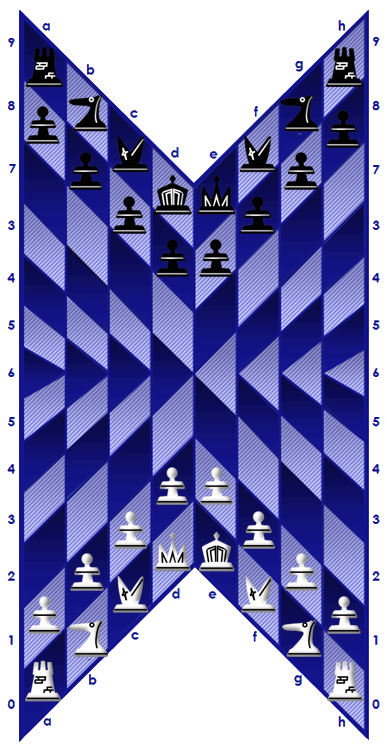Accelerated Chess
Accelerated Chess is a 2-player chess variant invented by Max Koval in 2021. This game is played by two players on an unconventionally-shaped rectangular board with 80 cells (9 rows and 8 columns) and incorporates one set of 32 white and black coloured pieces, which remain unchanged from the original FIDE chess set. The name comes after the board shape, and particularly the properties of the board's central part where the pieces are placed nearer to each other.
This game's page on the Chess Variant Pages was recreated in 2022 with corrected graphics and rewritten text with more clarified rules.
Setup

White: king e0; queen d0; rooks a0, h0; bishops c0, f0; knights b0, g0; pawns a1, b1, c1, d1, e1, f1, g1, h1.
Black: king d9; queen e9; rooks a9, h9; bishops c9, f9; knights b9, g0; pawns a8, b8, c8, d8, e8, f8, g8, h8.
The notation system for the board (as well as the further reference for the definition of orthogonals and diagonals).

To avoid using the two-digit number (10), zero is used as the mark for the first row.
Due to the board's geometry with bent rows, two separate cells can share the same name (a3, a4, a5, b3, etc.). To distinguish them from one another, it is required to mark them with the name of the player's half of the board (for example, the g3 cell, which is closer to the black pieces, is marked as g3 black, or g3b; the a4 cell, which is closer to the white pieces, is marked as a3w). You don't necessarily need to distinguish the cells if the piece can reach only one of them.
Pieces
The movement of the pieces works similarly to orthodox chess (no new rules are used) and is largely distorted due to the board's geometry.
The rook (orthogonal and horizontal moves). The rook's movement is largely affected by bent horizontals. When it reaches the central line of 'triangles', its move changes its direction from forward to left (1 diagram) or right, or vice versa, although if it already reached such kind of a cell, it can continue moving in an expected manner.

The bishop (diagonal moves). The bishop's move doubles when it reaches the center. This is similar to Zubrin's Three-player chess.

The queen moves like the rook and the bishop combined.
The king moves like the queen, but in only one cell of every direction, it also cannot be put under attack of the opponent's pieces.
Castling works in a similar way to orthodox chess, except that for black the directions of it are reversed.
The knight's move can be defined as one step in a horizontal or vertical direction, and then one step diagonally in an outward direction. As in standard chess, the knight jumps, and the piece that is jumped over is further not affected by it.

The pawn can make one cell without taking straight forward and capture 'diagonally' forward (if possible). The definition of 'forward' means that after every non-capturing move, the pawn should always be closer to the promotion zone (9th rank for white and the zero rank for black). If it has not moved yet, it is able to make a double step like in orthodox chess (c and f column), as well as a triple (b, g) and quadruple (a, h). Pawns, placed on the d and e columns are not capable to make a multistep.
Rules
With all the mentioned exceptions, all other rules are similar to standard FIDE chess.
 This 'user submitted' page is a collaboration between the posting user and the Chess Variant Pages. Registered contributors to the Chess Variant Pages have the ability to post their own works, subject to review and editing by the Chess Variant Pages Editorial Staff.
This 'user submitted' page is a collaboration between the posting user and the Chess Variant Pages. Registered contributors to the Chess Variant Pages have the ability to post their own works, subject to review and editing by the Chess Variant Pages Editorial Staff.
By Max Koval.
Web page created: 2022-11-23. Web page last updated: 2023-02-12
